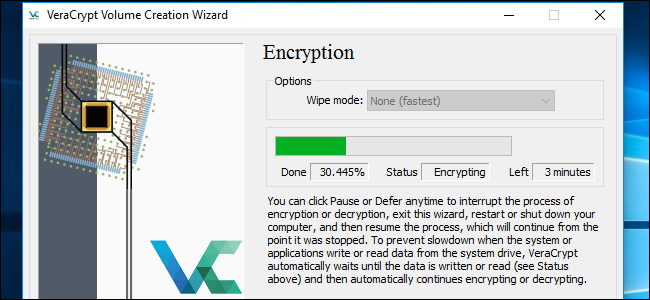

- #HOW TO USE VERACRYPT WINDOWS 10 INSTALL#
- #HOW TO USE VERACRYPT WINDOWS 10 WINDOWS 10#
- #HOW TO USE VERACRYPT WINDOWS 10 WINDOWS 8.1#
Participating in the increasingly common industry practice of eroding user privacy is in my opinion fundamentally different from installing a backdoor into an encryption solution.
#HOW TO USE VERACRYPT WINDOWS 10 WINDOWS 10#
In terms of the concerns over user privacy and some of Microsoft's other decisions, while I share those concerns and have my own gripes with Microsoft - like making Windows 10 perpetually free by treating everyone's Start menu as ad space - I personally don't let those concerns and frustrations extend to concerns over whether BitLocker is safe to use. and therefore may or may not survive that type of process.
#HOW TO USE VERACRYPT WINDOWS 10 INSTALL#
When you're using Microsoft's own solutions, you're much less likely to encounter issues during OS upgrades than when you're using third-party solutions that need to install their own custom bootloader, drivers, etc.

That in fact is one of the benefits of BitLocker over other solutions.
#HOW TO USE VERACRYPT WINDOWS 10 WINDOWS 8.1#
In terms of BitLocker and Windows updates, I've been using it since Windows 8.1 and have performed many in-place upgrades to new OS releases on many systems without having a single issue. Reflect can image BitLocker non-OS partitions just fine, as well as VeraCrypt OS partitions. For example, this thread created today suggests that backing up a TrueCrypt/VeraCrypt non-OS partition in unencrypted form might not be possible. That's not to say that Reflect would never work at all with file containers or partitions encrypted with those solutions, but I don't believe there would be any equivalent to the BitLocker Live Restore/Clone capability (particularly as I'm not even sure it's possible to unlock a TrueCrypt/VeraCrypt partition in a WinPE/Rescue Media environment, which would be necessary for OS disk restores) and in fact you might encounter some limitations. To my knowledge, Reflect does not have any "special" support for VeraCrypt or its predecessor TrueCrypt, and thus I don't think a similar KB exists for Reflect and those applications. I've used it with Reflect for quite a while now. So if you have access to BitLocker, then unless you prefer VeraCrypt for the open source angle, I'd go with BitLocker - in fact I actually HAVE gone with BitLocker. More details in that KB I linked earlier. By comparison, with BitLocker and paid versions of Reflect, if you're restoring a backup that was captured unencrypted and the target is still encrypted (as opposed to restoring onto a new disk), then the backup will be restored in a way that retains the existing encryption, which means you don't have to re-encrypt (and back up a new Recovery Key), and you also benefit from Rapid Delta Restore, which means Reflect only has to restore the differences between the target's current state and the backup you're restoring, rather than having to restore the entire partition. The bootloader works fine with a partition in unencrypted form, since it actually starts off that way when it runs the pre-encryption test. In terms of restoring, I haven't used VeraCrypt, but I've used its predecessor TrueCrypt, and my recollection is that if you restore a backup that was captured unencrypted, then Reflect always brings it back unencrypted, but it also brings back the TrueCrypt/VeraCrypt bootloader, so all you have to do is re-enable the encryption. The former is far preferable because in the latter scenario, Reflect will have to capture every sector of the partition, including unused space, and compression won't be useful because encrypted data doesn't compress. They'll be captured unencrypted if you run them while the partition is unlocked, otherwise they'll be captured in encrypted form.

If you prefer to use VeraCrypt, it should still capture backups fine. Reflect actually has some pretty extensive and handy support for BitLocker.


 0 kommentar(er)
0 kommentar(er)
